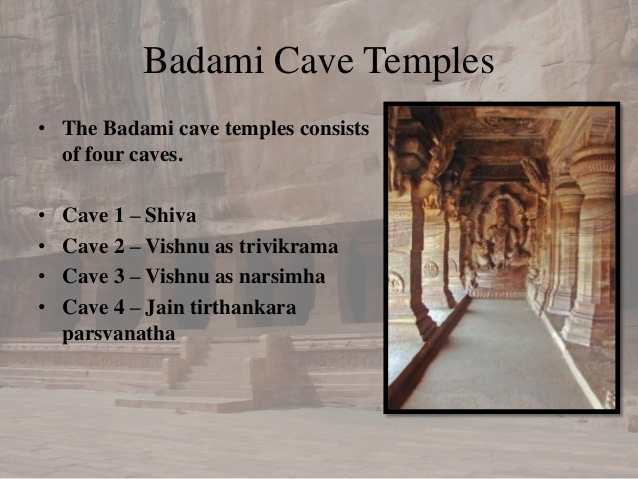The Chalukyas of Badami have made marvelous contributions to Indian Art and Architecture. Building of Stambha Mandapa (Navaranga) and Sukhanasi along with the Garbhagriha was a unique contribution of the Chalukyas. They built many temples following the Nagara or North Indian Style and Dravida or South Indian style. They built their temples using red sandstone. They experimented many things in temple building. They built small models of temples and, based on that, built the main temples. The Chalukyan art took birth at Aihole and developed in Badami and Pattadkallu. In this background, Percy Brown has called their architecture as “cradle of Indian temple architecture.” Badami, Ailhole and Pattadakal were the centers of their art.
Important Characteristic Features of Chalukyan Architecture
- Small base design
- Horse shoe base
- Square Garbhagriha
- Inner pradakshinapatha
- Mukhamandapa, Navaranga, Sukhanasi and Pyramidical Shikhara on the Garbhagirha
- Ekakuta, Dwikuta, Trikuta temples
Cave temples of Badami
Chalukyas built four rock-cut cave temples at Badami, which attract the attention of the visitors. They have Mukhamandapa, large Rangamandapa and Garbhagriha.
The Badami cave temples consists of four caves devoted to various Gods :-
- Cave 1 = Shiva
- Cave 2 = Vishnu as trivikrama
- Cave 3 = Vishnu as narasimha
- Cave 4 = Jain Trithankara Parshvanatha

Cave no. 1 belongs to Shaivism. The sculptures of Ardhanareeshwara and Nataraja here are very attractive. Cave no 2 and 3 belong to Vaishavism. Varaha and Vamana bas-reliefs in cave no. 2 are noteworthy. Cave no. 3 is the biggest of all and was built by Mangalesha. The Earth Goddess, Vishnu sitting on Shesha and Narasimha, Vamana, Balarama, Harihara sculptures attract the attention of the onlookers. Cave no 4 is the smallest. It is a Jain cave. Here we can see the sculptures of Mahaveera, his disciple Gautama, and Parshvanatha, the 23rd Trithankara. In course of time the above Basadi came to be called Melana or Mena Basadi.
Though Badami is famous for cave temples, we can see a few artistic temples also here. Among them, Malagitti Shiva, Bhuthanatha, Lakumeesha and Virupaksha temples are important.
Aihole
Another center of Badami Chalukyan art, Aihole was once a famous trading center. We can see a number of examples of Chalukyan temples here.
Ladh Khan Temple
It is the earliest of the temples of Chalukyan art. It has a Mukhamandapa, Garbhagriha with a Nandi idol in front of the temple. Henry Cousins, the art critic, called it a Vaishnava temple, because of the sculpture of Garuda on the door of the Garbhagriha. But the Nandi idol shows that the Garbhagriha had once a Shivalinga. Since a Muslim saint Ladh Khan by name lived here for a number of years, people called it Ladh Khan temple.
Durga Temple
It is a very special temple among the temples at Ailhole. This is a Sun temple designed on the model of Horse shoe and Buddhist Chaityalaya. The Shikara of this temple resembles those of Orissa temples. Rangamandapa with two rows of pillars and Verandahs on the two sides go till the Garbhagriha and merge in a semicircle, which amazes the onlookers. Since the temple is surrounded by the fort wall, it is called the fort (Durga) temple.
A group of Konthi temples, also known as Kwathi Gudi, are seen in front of the fort temple. They are the ancient temples of Badami Chalukyas and were model temples built as an experiment.
Huchchimalligudi
Huchchimalligudi is a small temple with a simple style. It has square pillars.
Meguti Jain Temple
Meguti Jain temple is situated on a small hill near Aihole. It was built by Ravikeerti. The Aihole inscription is written on the eastern wall of this temple. This temple which has a Mukhamandapa, Madhyarangamandapa and Garbhagriha is built in the Dravida style. It is called Melagudi as it is built on the hill. According to scholars, gradually Megudi became Meguti.
Shivalinga, Varsha, Kali and Nataraja bas-reliefs in the Ravalgudi cave at Aihole attract our attention. The other important temples of Aihole are Jyotirlinga, Mallikarujuna and Siddheshwara etc. The Ramalinga temple, half a mile away from Aihole, has three Garbhagrihas.
Pattadakal
The ancient name of Pattadakal was “Kisuvolalu”. Many temples of Badami Chalukyas are here. Kasi Vishwanatha, Papanatha, Jambulingeshwara temples etc. are in the Nagara style and Sangameshwara, Virupaksha and Mallikarjuna temples are in the Dravida style.
Virupaksha Temple (Lokeshwara Temple)
It is the most important among the temples at Pattadakal. In memory of 3 victories over the Pallavas by Vikramaditya II, his queen Lokamahadevi built this temple. The architect of this temple was Anirvatachari Gunda. It is 224 ft long and 105 ft broad. The temple looks like being held by lions and elephants holding the beams. There is a huge sculpture of Nandi in the Nandi mandapa in front of the temple. This temple which has a Mukhamandapa, Mahamandapa and Garbhagriha has a Shikhara in the Dravida style. The idol of Surya in the Ardhamandapa is the most beautiful.
Mallikarjuna (Trilokeshwara)
Mallikarjuna temple, which resembles the Virupaksha temple is situated next to it. This temple was built by Triloka Mahadevi, another queen of Vikramaditya II. Mahakuteshwara temple at Mahakuta is also a beautiful specimen of Chalukyan art.
Also read about >>
Buddhist Architecture – Monasteries and Stupas
2 Comments on “Important Characteristic Features of Chalukyan Architecture”
To know the general knowledge
Truely helpful